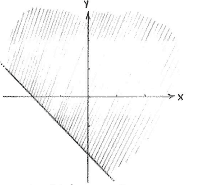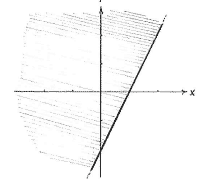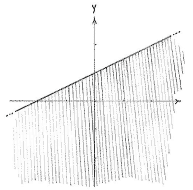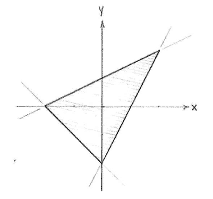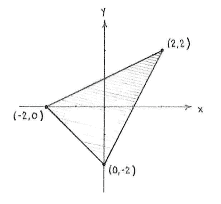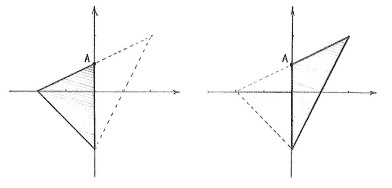Lösung 2.2:9c
Aus Online Mathematik Brückenkurs 1
K (hat „Solution 2.2:9c“ nach „Lösung 2.2:9c“ verschoben: Robot: moved page) |
|||
| Zeile 1: | Zeile 1: | ||
| - | + | Wir zeichnen zuerst die Gebiete die durch die drei Ungleichungen entstehen. | |
{| align="center" | {| align="center" | ||
| Zeile 13: | Zeile 13: | ||
|} | |} | ||
| - | + | Das Dreieck ist das Gebiet dass wo die Punkte alle dre Ungleichungen erfüllen, also das Gebiet das alle grau gefärbten Gebiete enthält. | |
| Zeile 19: | Zeile 19: | ||
| - | + | Als erster Schritt müssen wir die Schnittpunkte der Geraden berechnen, die also auch die Ecken des Dreiecks sind. | |
| - | + | Die drei Ecken müssen jeweils die Drei Gleichungssysteme unten erfüllen | |
{{Abgesetzte Formel||<math>(1)\ \left\{\begin{align} x+y&=-2,\\ 2x-y&=2,\end{align}\right.\qquad | {{Abgesetzte Formel||<math>(1)\ \left\{\begin{align} x+y&=-2,\\ 2x-y&=2,\end{align}\right.\qquad | ||
| Zeile 28: | Zeile 28: | ||
(3)\ \left\{\begin{align} 2x-y &= 2,\\ -x+2y &= 2,\end{align}\right.</math>}} | (3)\ \left\{\begin{align} 2x-y &= 2,\\ -x+2y &= 2,\end{align}\right.</math>}} | ||
| - | we obtain an equation system which determines the points of intersections between respective pairs of lines, and these points correspond to the triangle's corners. | ||
<ol> | <ol> | ||
| - | <li> | + | <li>Das erste Gleichungssystem lösen wir indem wir die beiden Gleichungen addieren |
{| align="center" style="padding:10px 0px 10px 0px;" | {| align="center" style="padding:10px 0px 10px 0px;" | ||
|| | || | ||
| Zeile 57: | Zeile 56: | ||
|} | |} | ||
| - | + | So erhalten wir also <math>x=0</math>, und von der Glcihung <math>x+y=-2</math> erhalten wir <math>y=-2</math>.</li> | |
| - | <li> | + | <li>Im zweiten System können wir die Gleichungen genauso addieren |
{| align="center" style="padding:10px 0px 10px 0px;" | {| align="center" style="padding:10px 0px 10px 0px;" | ||
|| | || | ||
| Zeile 84: | Zeile 83: | ||
|} | |} | ||
| - | + | Wir erhalten also <math>y=0</math> und <math>x=-2</math>.</li> | |
| - | <li> | + | |
| + | <li>Das dritte System ist ein wenig schwieriger zu lösen. Hier müssen wir ''y'' in der zweiten Gleichung mit <math>2x-2</math> ersetzen (von der ersten Gleichung), und danach ''x'' in die erste Gleichung einsetzen. | ||
{{Abgesetzte Formel||<math>-x+(2x-2)=2\quad\Leftrightarrow\quad 3x-4=2\quad\Leftrightarrow\quad x=2\,\textrm{.}</math>}} | {{Abgesetzte Formel||<math>-x+(2x-2)=2\quad\Leftrightarrow\quad 3x-4=2\quad\Leftrightarrow\quad x=2\,\textrm{.}</math>}} | ||
| - | + | Und also ist <math>y=2\cdot 2-2 = 2\,\textrm{.}</math></li> | |
</ol> | </ol> | ||
| - | + | Die Ecken des Dreiecks sind also (0,-2), (-2,0) und (2,2). | |
| Zeile 98: | Zeile 98: | ||
| - | + | Wenn wir die Fläche des Dreiecks mit der Gleichung | |
{{Abgesetzte Formel||<math>\text{Area} = \tfrac{1}{2}\text{(base)}\cdot\text{(height)}</math>}} | {{Abgesetzte Formel||<math>\text{Area} = \tfrac{1}{2}\text{(base)}\cdot\text{(height)}</math>}} | ||
| - | + | berechnen, ist das Problem die Basis und die Höhe des Dreiecks zu berechnen, nachdem keine Kante mit der ''x''- oder ''y''-Achse parallel ist. Wir können aber das Dreieck in zwei Dreiecke aufteilen, die beide eine Kante haben, die parallel mit der ''y''-Achse ist. | |
[[Image:2_2_9_c-4(5).gif|center]] | [[Image:2_2_9_c-4(5).gif|center]] | ||
| - | + | Hier entsteht ein neuer Eckpunkt, A, den wir berechnen müssen. Wir sehen dass der Punkt A die Schnittstelle zwischen der Gerade <math>2y-x=\text{2 }</math> und der ''y''-Achse ist | |
| - | + | ||
| - | <math>2y-x=\text{2 }</math> | + | |
{{Abgesetzte Formel||<math>\left\{\begin{align} 2y-x&=2\\ x&=0\\ \end{align}\right.</math>}} | {{Abgesetzte Formel||<math>\left\{\begin{align} 2y-x&=2\\ x&=0\\ \end{align}\right.</math>}} | ||
| - | + | Die Schnittstelle, und der Punkt A, ist also (0,1). | |
| - | + | Jetzt können wir einfach die Flächen des beiden Dreiecken berechnen | |
Version vom 13:54, 13. Mär. 2009
Wir zeichnen zuerst die Gebiete die durch die drei Ungleichungen entstehen.
| The region x + y ≥ -2 | The region 2x - y ≤ 2 |
| The region 2y - x ≤ 2 |
Das Dreieck ist das Gebiet dass wo die Punkte alle dre Ungleichungen erfüllen, also das Gebiet das alle grau gefärbten Gebiete enthält.
Als erster Schritt müssen wir die Schnittpunkte der Geraden berechnen, die also auch die Ecken des Dreiecks sind.
Die drei Ecken müssen jeweils die Drei Gleichungssysteme unten erfüllen
| \displaystyle (1)\ \left\{\begin{align} x+y&=-2,\\ 2x-y&=2,\end{align}\right.\qquad
(2)\ \left\{\begin{align} x+y &= -2,\\ -x+2y &= 2,\end{align}\right.\qquad \text{and}\qquad (3)\ \left\{\begin{align} 2x-y &= 2,\\ -x+2y &= 2,\end{align}\right. |
- Das erste Gleichungssystem lösen wir indem wir die beiden Gleichungen addieren
So erhalten wir also \displaystyle x=0, und von der Glcihung \displaystyle x+y=-2 erhalten wir \displaystyle y=-2.\displaystyle x \displaystyle {}+{} \displaystyle y \displaystyle {}={} \displaystyle -2 \displaystyle +\ \ \displaystyle 2x \displaystyle {}-{} \displaystyle y \displaystyle {}={} \displaystyle 2
\displaystyle 3x \displaystyle {}={} \displaystyle 0 - Im zweiten System können wir die Gleichungen genauso addieren
Wir erhalten also \displaystyle y=0 und \displaystyle x=-2.\displaystyle x \displaystyle {}+{} \displaystyle y \displaystyle {}={} \displaystyle -2 \displaystyle +\ \ \displaystyle -x \displaystyle {}+{} \displaystyle 2y \displaystyle {}={} \displaystyle 2
\displaystyle 3x \displaystyle {}={} \displaystyle 0 - Das dritte System ist ein wenig schwieriger zu lösen. Hier müssen wir y in der zweiten Gleichung mit \displaystyle 2x-2 ersetzen (von der ersten Gleichung), und danach x in die erste Gleichung einsetzen.
Und also ist \displaystyle y=2\cdot 2-2 = 2\,\textrm{.}\displaystyle -x+(2x-2)=2\quad\Leftrightarrow\quad 3x-4=2\quad\Leftrightarrow\quad x=2\,\textrm{.}
Die Ecken des Dreiecks sind also (0,-2), (-2,0) und (2,2).
Wenn wir die Fläche des Dreiecks mit der Gleichung
| \displaystyle \text{Area} = \tfrac{1}{2}\text{(base)}\cdot\text{(height)} |
berechnen, ist das Problem die Basis und die Höhe des Dreiecks zu berechnen, nachdem keine Kante mit der x- oder y-Achse parallel ist. Wir können aber das Dreieck in zwei Dreiecke aufteilen, die beide eine Kante haben, die parallel mit der y-Achse ist.
Hier entsteht ein neuer Eckpunkt, A, den wir berechnen müssen. Wir sehen dass der Punkt A die Schnittstelle zwischen der Gerade \displaystyle 2y-x=\text{2 } und der y-Achse ist
| \displaystyle \left\{\begin{align} 2y-x&=2\\ x&=0\\ \end{align}\right. |
Die Schnittstelle, und der Punkt A, ist also (0,1).
Jetzt können wir einfach die Flächen des beiden Dreiecken berechnen
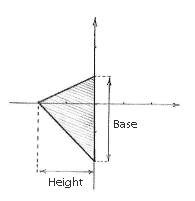
| 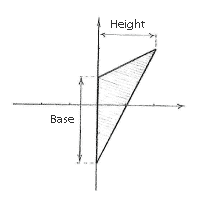
| |||||
| base | = | 1 - (-2) = 3 | base | = | 1 - (-2) = 3 | |
| height | = | 0 - (-2) = 2 | height | = | 2 - 0 = 2 | |
| area | = | ½·3·2 = 3 | area | = | ½·3·2 = 3 | |
Finally, it remains only to add up the sub-areas to get the total area of the triangle:
| \displaystyle \text{Area} = 3+3=6\,\textrm{.} |
